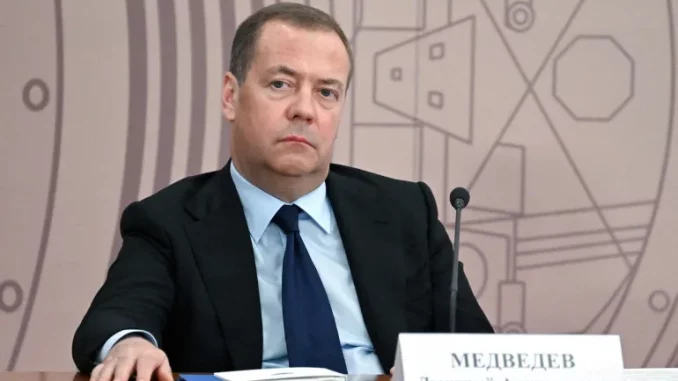
Russia’s ex-president and current Security Council deputy chairman, Dmitry Medvedev, in June 2024 [File: Alexei Maishev/Sputnik/Pool via Reuters]
| Published August 6, 2025
🔥 Key Developments: Russia Withdraws from Missile Moratorium & Issues Nuclear Warnings
1. Infraction-Free Missile Deployment
-
Russia has officially abandoned its self‑imposed ban on deploying intermediate-range missiles (500–5,500 km range)—even those capable of carrying nuclear warheads.
-
Kremlin spokesperson Dmitry Peskov emphasized that “Russia no longer has any restrictions… considers itself entitled… to take appropriate steps” if necessary .
-
Moscow views U.S. deployments—such as Typhoon and Dark Eagle missiles in Germany and exercises near the Philippines and Australia—as direct threats to national security.
2. Medvedev’s Hawkish Messaging
-
Dmitry Medvedev, serving as Deputy Head of the Security Council, issued a pointed warning that NATO’s “anti‑Russian policy” prompted the move and vowed “further steps” without specifying what they might entail.
-
He framed this shift as a new geopolitical reality that the West must reckon with—and signaled possible escalation.
3. Nuclear Saber-Rattling and U.S. Response
-
Russia’s Foreign Ministry declared it would respond with “military‑technical measures” to restore what it calls a “strategic balance,” implicitly including nuclear-capable systems.
-
U.S. President Trump reacted to Medvedev’s rhetoric by repositioning two U.S. nuclear submarines to strategic regions, warning about the risk of “unintended consequences” from inflammatory statements.
-
The Kremlin, while not escalating publicly, urged caution in nuclear-related discourse and reiterated that it does not intend further escalation at this time.
📋 Why It Matters
| Issue | Significance |
|---|---|
| Collapse of INF-style arms limits | The demise of voluntary U.S.–Russia constraints reignites long-standing fears of a renewed arms race and potential Cold War-era escalation. |
| Proximity of launch zones | With missiles potentially stationed closer to rival capitals, warning times shrink to mere minutes, increasing the risk of miscalculation or accidental use. |
| Nuclear doctrine concerns | Russia’s explicit reference to missiles capable of carrying nuclear warheads signals a more aggressive posture. Its military doctrine retains the option to use nuclear force if existential threats arise. |
| Diplomatic flashpoints | The ongoing exchange of threats between Putin/Medvedev and Trump, alongside an ultimatum over Ukraine, underscores deteriorating diplomatic channels. |
🔮 Outlook & What’s Next
-
Analyst assessment: Some experts argue Russia’s moratorium had already become moot—it was symbolic rather than substantive—but the public reversal still serves as a deliberate signal to Europe and NATO.
-
Possible deployments: Russia is reportedly moving ahead with production and deployment of the hypersonic “Oreshnik” missile, capable of Mach 10 speeds and dual conventional/nuclear payloads, including in Belarus near NATO borders.
-
Risk of escalation: Observers warn that this escalation of missile posturing and nuclear rhetoric could lead to dangerous miscalculations during periods of high tension—as warning times shrink to minutes in Central Europe.
 Implications:
Implications:
Here are the key implications of Russia’s decision to abandon missile limits and escalate nuclear rhetoric:
1. Renewed Arms Race in Europe and Asia
-
End of constraints on intermediate-range missiles means both Russia and NATO allies (especially the U.S.) may deploy advanced weapons in sensitive zones like Eastern Europe and the Western Pacific.
-
Could trigger retaliatory deployments by NATO, Japan, and possibly South Korea, escalating tensions across multiple theaters.
2. Reduced Warning Times = Higher Risk of Miscalculation
-
Intermediate-range missiles can hit targets within minutes, leaving little to no time for verification or diplomacy during a crisis.
-
Raises the chance of a “launch-on-warning” doctrine, increasing the probability of accidental nuclear war.
3. Collapse of Global Arms Control Architecture
-
Russia’s withdrawal signals a complete breakdown of the INF (Intermediate-Range Nuclear Forces) framework, once a cornerstone of Cold War stability.
-
Sets a precedent for China or other nuclear-armed states to ignore or bypass similar constraints.
4. Greater Pressure on NATO Cohesion
-
NATO nations may disagree over how to respond—Germany and France could resist hosting new U.S. missiles, while Eastern European states like Poland or the Baltics may request them.
-
This could expose internal rifts in NATO’s strategy and weaken its unified deterrence posture.
5. Increased Risk in Conflict Zones (Ukraine, Taiwan)
-
Russia may now threaten or actually deploy nuclear-capable missiles to deter deeper Western involvement in Ukraine.
-
The U.S. and its allies may respond with similar strategies in Asia, particularly near Taiwan—increasing pressure on China and raising regional stakes.
6. Escalation of U.S.–Russia Tensions
-
The Trump–Medvedev exchange shows how quickly military signaling can escalate.
-
Submarine repositioning and missile deployments create a new standoff dynamic, akin to the Cuban Missile Crisis.
7. Propaganda and Political Leverage
-
Russia may use this move to bolster internal support, framing the West as aggressors.
-
It can also be used as leverage in future negotiations or to intimidate smaller nations aligned with NATO.
 Overall Takeaway:
Overall Takeaway:
Russia’s decision to abandon all restrictions on intermediate-range missile deployment—paired with sharp nuclear warnings from senior officials like Medvedev—marks a dangerous escalation in global security tensions.
This shift signifies the formal end of the post–Cold War arms control era, opening the door to a new, unpredictable phase of strategic competition. With missiles now deployable closer to enemy territory and rhetoric intensifying between major powers, the risk of miscalculation, accidental conflict, or rapid escalation has sharply increased.
The international community faces a stark choice: either rebuild diplomatic channels and arms control frameworks—or continue down a path that leads toward confrontation, instability, and possibly nuclear brinkmanship.
As the geopolitical landscape tilts further toward confrontation, the need for clear-eyed strategy, restraint, and renewed dialogue has never been more urgent.
SOURCES: NEWSWEEK – Russia Issues Nuclear Weapons Warning: ‘No Limits’
AL JAZEERA – Russia’s Medvedev issues warning as Moscow says not bound by missile treaty
REUTERS – Russia says it has ‘no restrictions’ now on intermediate-range missile deployment





Be the first to comment